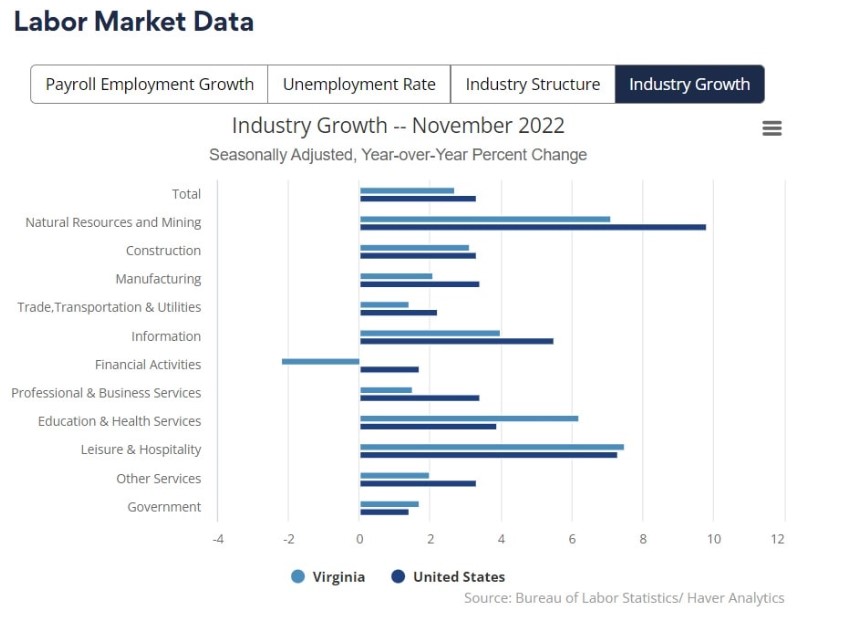The Virginia region has seen lagging growth in several key industries over the past year. According to the Regional Economic Snapshot from the Federal Reserve Bank of Richmond, Virginia’s year-over-year percent growth has lagged behind the national average in almost every industry. The data also presents some outliers, such as the education and health services sector realizing nearly double the national average percent change. Meanwhile, the financial services sector has seen a decrease in growth.

Below, we discuss what might be driving these trends and what it means for the regional business community. Be sure to further explore the Fed Richmond Economic Outlook for 2023 speech by Tom Barkin, President.
What’s Driving These Industry Trends?
One of the main drivers of the strong growth in the education and health services sector – including here in Northern Virginia -is the presence of several major universities and hospitals in the region. Northern Virginia is home to the #1 high school in the US, Thomas Jefferson High School, and a few top-ranked universities, such as George Mason University and satellite campus investments by UVA, Virginia Tech and other colleges. The region also includes several major hospitals and medical centers, including Inova Fairfax Hospital and Reston Hospital Center. These schools and healthcare facilities contribute significantly to the local economy and likely help drive strong growth in the education and healthcare sector.
Despite the significant growth in the education and health services sector, Virginia’s financial services sector has seen a decrease in growth. One possible reason for this is the overall decline in the financial services industry nationwide, which has been affected by many factors, including increased regulation and competition. Additionally, COVID-19 has had a significant impact on the financial services industry, with many companies facing challenges such as reduced demand and lower revenues. Inflation and recession pressures have also severely curtailed both the ability of local businesses to get loans, as well as the business demand for these loans – which therefore cuts deep into local bank financing business.
In terms of overall industry growth, Virginia has lagged behind the national average in almost every sector – and perhaps most concerning, in the “professional & business services” industry sector, which is the largest employment share (check the “industry structure” tab on the Labor Market Data dashboard). One possible reason for this is the maturity of the region, with oversaturated competition making it difficult to achieve significant growth (led by Northern Virginia). Additionally, Northern Virginia’s high cost of living may have made it harder for businesses to attract and retain employees, which could have contributed to slower growth in some industries.
What Does This Mean for the Regional NOVA Business Community?
In an otherwise difficult economic landscape ahead, there are some bright spots Northern Virginia organizations can focus on. The growth of certain industries in Northern Virginia, particularly education and health services, is notable. For businesses operating in these sectors, this strong growth is a positive sign and may indicate ample opportunity for expansion. These organizations may be more likely to invest in marketing and other spending efforts to capitalize on recent growth and attract new customers.
For businesses operating in industries that aren’t seeing as much growth, such as the financial services sector, the situation may be more challenging. These businesses may need to focus on finding ways to adapt and stay competitive to continue to grow and succeed. Perhaps local organizations can reap some rewards from the region’s well-performing industries in one way or another. This could include a variety of strategies, such as expanding into new markets, investing in new technologies, or reevaluating their marketing and spending plans to make the most of their limited resources. This could also look like marketing and business development efforts highlighting alignment with better healthcare and education outcomes – i.e. tying family health and education benefits to product and service benefits.
The Bottom Line
Despite the aforementioned challenges, Virginia and particularly Northern Virginia remains a vibrant and mature region. While the region has seemingly lagged behind, its slowing growth is also a sign of a maturing economy and a safe investment for new businesses, homeowners, and otherwise. As the region continues to evolve and adapt to changing economic conditions, it’s safe to say we’ll see further growth and development in the years ahead, with some continued insulation from government spending..
Overall, the growth of certain industries in Northern Virginia can have both positive and negative impacts on the regional business community. Businesses operating in growing sectors may benefit from increased demand and opportunities for expansion, while those operating in declining sectors may face more challenges. In either case, it’s important for businesses to stay attuned to market trends and to be proactive in finding ways to adapt and stay competitive, especially with a potential recession looming ahead.
Gain Invaluable Insight into the Ongoings and Trends of Northern Virginia
WestXDC offers Northern Virginia organizations a comprehensive and insider’s view of regional industry trends, consumer behavior, and economic conditions. This combination of 1st, 2nd and 3rd-party data is incredibly valuable, as it can help you understand the local market and identify pertinent opportunities and threats. By receiving data insights from WestXDC, you can be confident you’re wielding accurate and reliable information to make business decisions. For more information about how WestXDC can inform your organization, fill out our online contact form.

